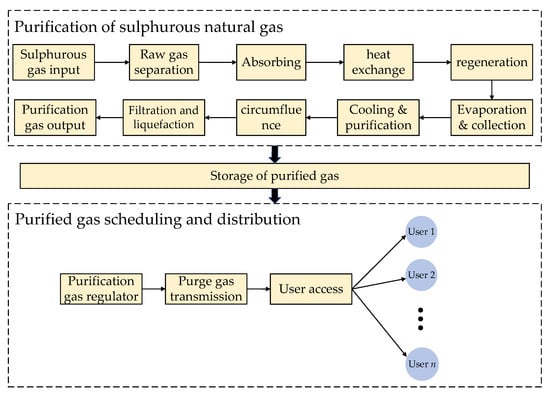With the acceleration of industrialisation and the increase in energy consumption, the problem of environmental pollution is becoming more and more serious, especially atmospheric pollution, which has a great impact on human health and the ecosystem. In order to solve the problems of environmental pollution and energy consumption, people have tried to process traditional natural gas on the basis of its further purification, in order to remove a small amount of natural gas contained in the sulphide and other impurities; the purified natural gas can be referred to as purified gas. Purified gas is a kind of natural gas that has been processed and desulphurised by a purification device to reach a certain quality index, and at the same time some impurities, such as hydrogen sulphide, carbon dioxide, and other acid gases, have also been removed from it. As a key link in industrial production for the reduction of harmful gas emissions, it is important for environmental protection to make accurate estimations and predictions of its usage data so as to carry out reasonable and accurate scheduling for purified gas [1].
Traditional purified gas prediction methods rely on empirical models and statistical analyses, which often have limitations when dealing with complex, non-linear industrial data. In recent years, machine learning techniques, with their powerful feature learning capabilities and ability to handle complex data, have demonstrated excellent performance in a number of fields, offering new possibilities for purge gas forecasting. The use of machine learning for purified gas as well as natural gas load prediction has become a popular method; for example, reference [2] proposed a natural gas load based on a Convolution Neural Network (CNN) and bidirectional Long Short-Term Memory (LSTM). A natural gas load forecasting model based on LSTM was proposed in reference [3], a natural gas load forecasting model using Empirical Mode Decomposition (EMD) combined with a time series model was proposed in reference [4], and a natural gas load forecasting model based on the Sparrow Search Algorithm (SSA) was proposed in reference [5]. A Sparrow Search Algorithm (SSA)-optimised Recurrent Neural Network (RNN) natural gas load forecasting model was proposed in reference [6], and reference [7] proposed a natural gas load forecasting model based on a Back-Propagation Neural Network (BPN). Back-Propagation Neural Network (BPNN) algorithm-based natural gas load forecasting model was proposed in reference [8], resulting in a natural gas load forecasting model based on a Genetic Algorithm (GA)-improved BPNN algorithm; reference [9] proposed a seasonal time series analysis model based on seasonal time series analysis considering the seasonal change pattern of the natural gas load data; and reference [10] proposed a seasonal time series analysis model based on SSA-LSTM. A natural gas load forecasting model based on a seasonal time series analysis algorithm was proposed in reference [10], which firstly decomposes the seasonal trend of natural gas data, and then establishes different neural network models for the decomposed data to make forecasts. And a short-term natural gas load forecasting model based on a Deep Belief Network (DBN) was proposed in reference [11]. In reference [12], a short-term gas prediction model based on a Time Convolution Network (TCN) combined with a two-way GRU algorithm was proposed, while in reference [13] a gas prediction model based on a Wavelet Neural Network (WNN) was proposed. However, the literature outlined above still has some limitations and drawbacks. For example, when the time sequence prediction algorithm Autoregressive Integrated Moving Average Model (ARIMA) is used to predict the purified natural gas load, it is not sensitive enough to stochastic variations and its predictive performance is more limited. This type of method is usually applied to time series with a trend and no seasonal component, which makes this method less accurate due to seasonal trends in purified natural gas load. Also, regarding the literature mentioned above, it all proposes to predict daily or even yearly natural gas load data, so it cannot predict hourly natural gas load data precisely. For hourly data prediction, compared to daily or even yearly data prediction, the measured data can reduce the influence of data variance and measured error. Simultaneously, the established model is more real-time so that it is better able to meet the requirements of real-time scheduling and distribution for most industries.
Transformer, nowadays one of the more popular deep learning models, which was mainly proposed by Vaswani et al. in 2017 [14], has achieved remarkable results in the field of natural language processing, such as machine translation, text categorisation, sentiment analysis, etc., as well as in tasks such as computer vision and speech recognition, due to its excellent parallel processing capability and long-distance dependency capture ability. As for the Gate Recurrent Unit (GRU) model, it was proposed as an improved version of CNN by Cho et al. in 2014 [15]. It effectively balances short-term and long-term memory mainly through the gating mechanism, reduces model parameters, alleviates the gradient vanishing problem, and demonstrates powerful modelling capabilities in the fields of natural language processing and time series analysis such as stock price prediction, weather prediction, and so forth.
In summary, in terms of the above algorithms that have been used for natural gas load forecasting, they all use days as the forecasting unit, with a low granularity of prediction, and at the same time, their accuracy of prediction is low, and the robustness and applicability of these models are also poor. Therefore, on the basis of the above studies, this paper proposes an hourly prediction algorithm for purified natural gas based on Transformer–GRU. The main contributions and innovations of this paper are as follows:
Source link
Chang Su www.mdpi.com

